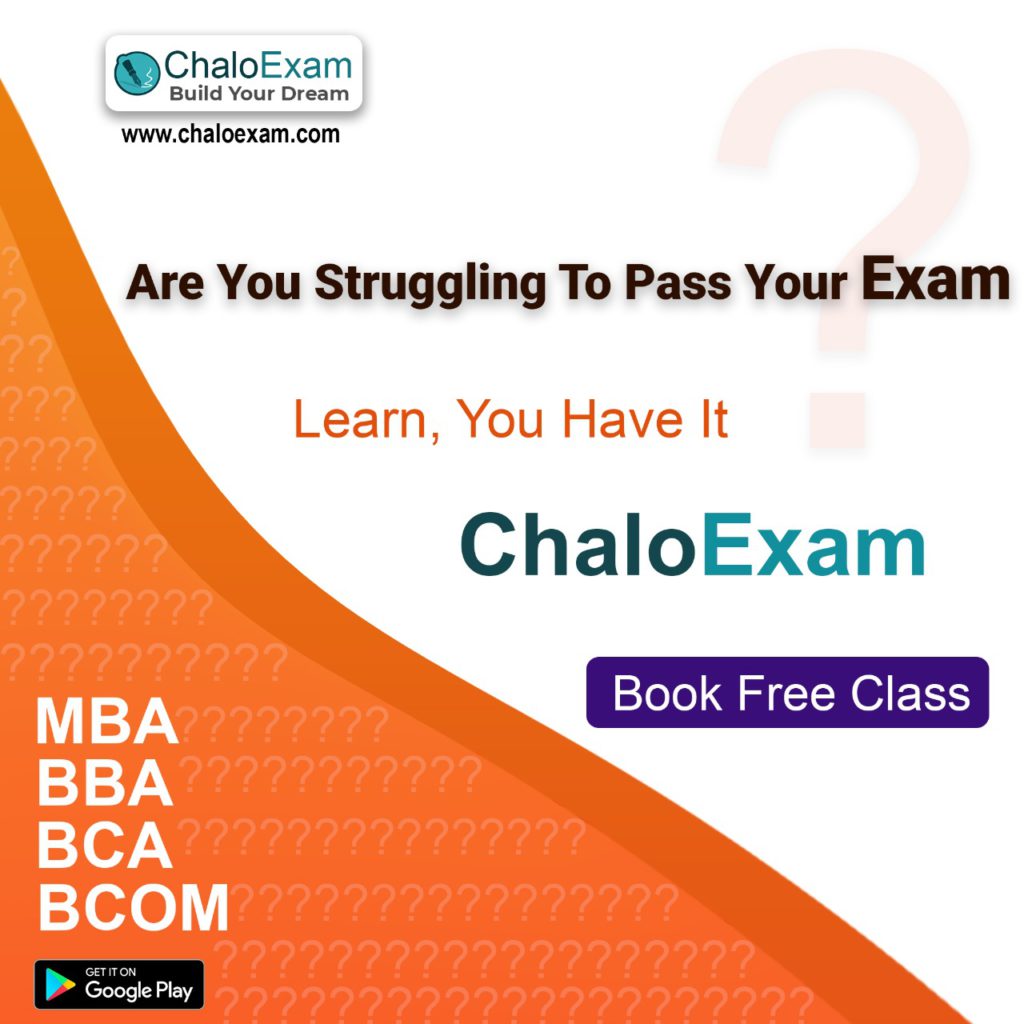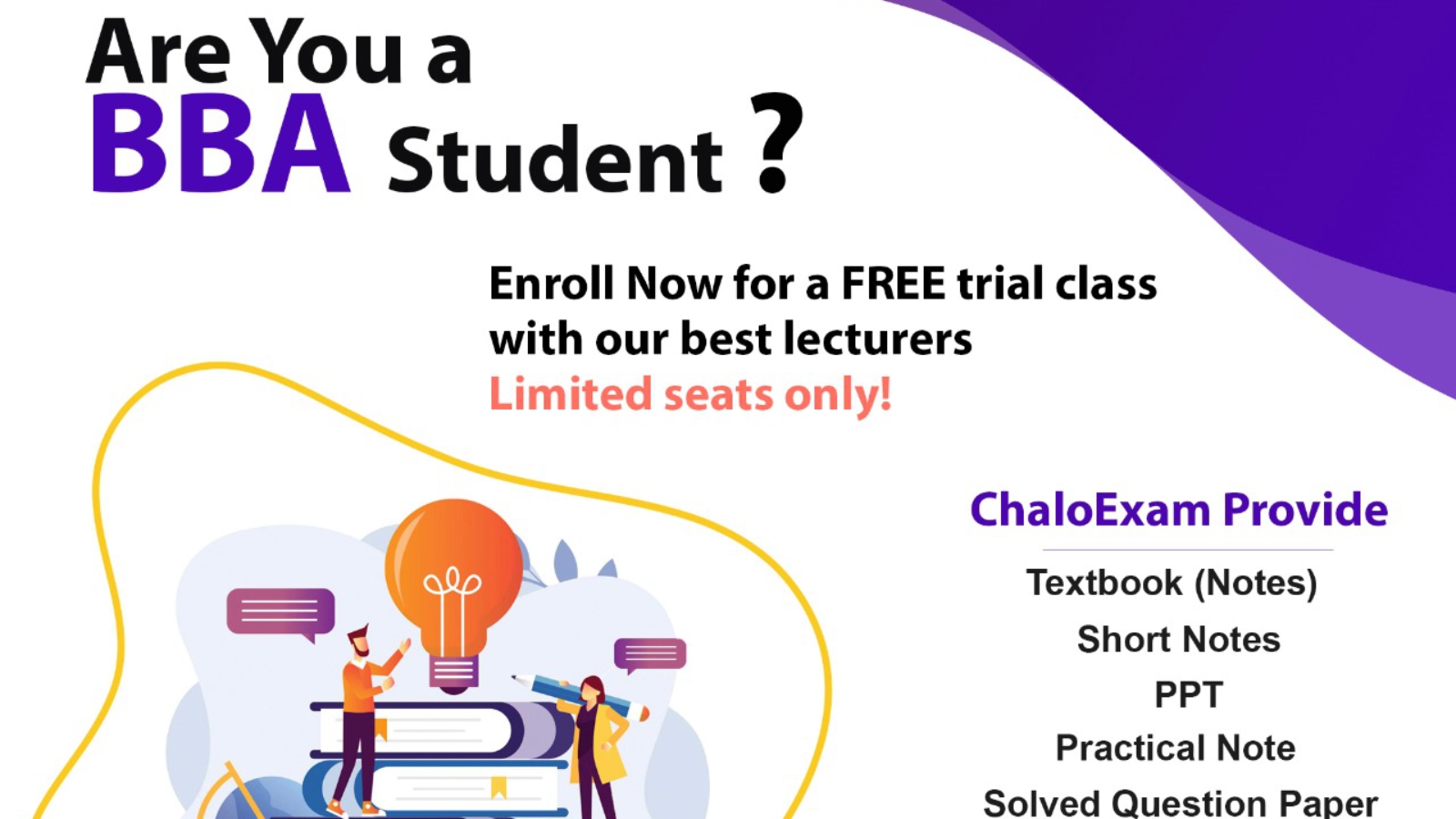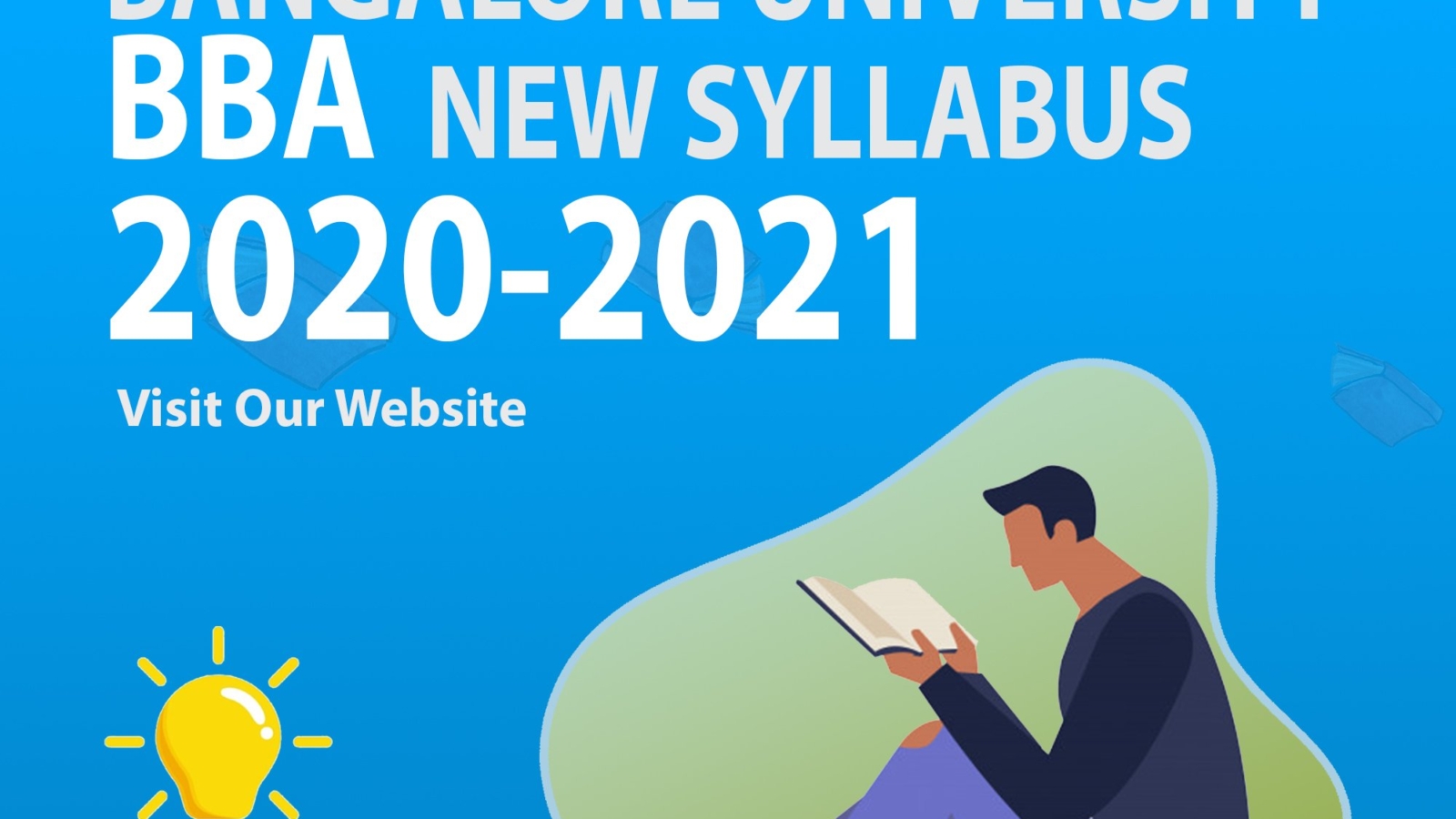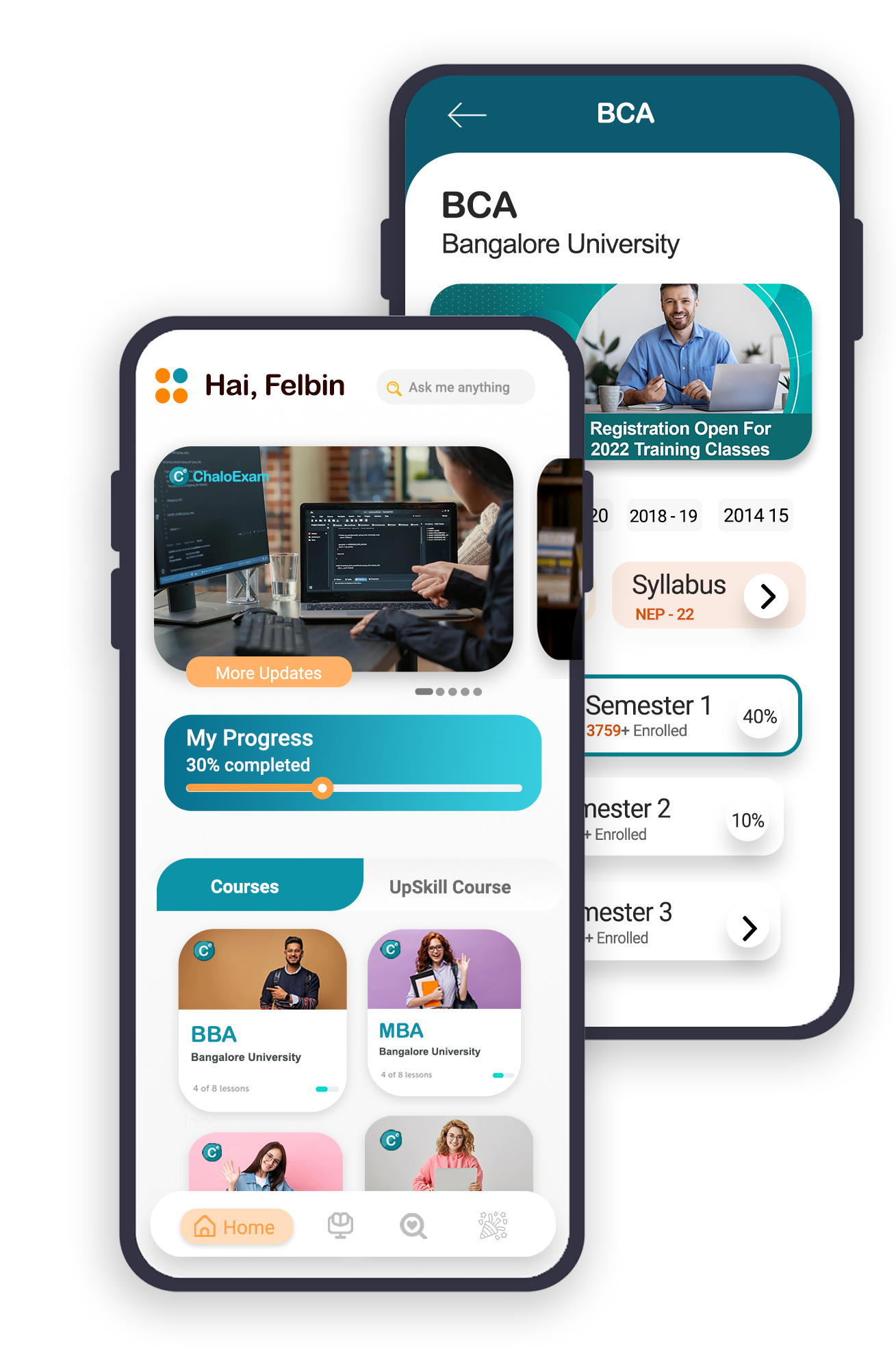Book Free Classes
Download free BBA 2nd sem module wise notes, latest solved question papers, previous 5 years question paper till 2021, model question papers, easy notes, exam oriented notes are available on this website chaloexam.com of Bangalore University
Bangalore University 2nd Sem BBA Study Materials (New Syllabus)
New Syllabus
Syllabus
2.3 FINANCIAL ACCOUNTING
OBJECTIVE:
The objective of this course is to help the students to acquire knowledge; financial reporting on the global scenario , skills and acumen of accounting treatment in respect of different categories of business undertakings and special type of business,
UNIT-1 INTRODUCTION TO IFRS 4 Hrs
Need for IFRS-Features of IFRS-Applicability of IFRS-Beneficiaries of Convergence with IFRS (theory only)
UNIT-2 ACCOUNTING FOR HIRE-PURCHASE 14 Hrs
Meaning of Hire Purchase and Installment Purchase System - Legal provisions - Calculation of interest - when rate of interest and cash price is given - when cash price and total amount payable is given, when rate of interest and installments amount are given but cash price is not given - Calculation of cash price under annuity method - Journal Entries and Ledger Accounts in the books of Hire Purchaser and Hire Vendor (Asset Accrual Method only).
UNIT-3 ROYALTY ACCOUNTS 14Hrs
Introduction - meaning - technical terms - royalty - landlord - tenant - minimum rent - short workings - recoupment of short working under - fixed period - floating period - recoupment within the life of a lease - treatment of strike, stoppage of work and sub-lease - accounting treatment in the books of lessee(tenant) - when royalty is less than minimum rent - when royalty is equal to minimum rent - when the right of recoupment is lost - when minimum rent account method is followed -
passing journal entries and preparation of Ledger Accounts - royalty account - landlord account – short workings account - minimum rent when minimum rent account is followed in the books of lessee only
UNIT-4 SALE OF THE PARTNERSHIP FIRM 16 Hrs Introduction - need for conversion - meaning of purchase consideration - methods of calculating purchase consideration - net payment method - net asset method - passing of journal entries and preparation of ledger accounts in the books of vendor - treatment of certain items - dissolution expenses - unrecorded assets and liabilities - assets and liabilities not taken over by the purchasing company - contingent liabilities - non- assumption of trade liabilities- in the books of purchasing company - passing of incorporation entries - treatment of security premium - fresh issue of shares and debentures to meet working capital - preparation of balance sheet as per 'Companies Act' 2013 - under vertical format.
G
UNIT: 5: ACCOUNTING FOR JOINT VENTURES 08 Hrs
Introduction – Meaning – Objectives – Distinction between joint venture and consignment – Distinction between joint venture and partnership – maintenance of accounts in the books of coverturers – maintaining separate books for joint venture -- problems.
BUSINESS LAB ACTIVITIES:
( Skill development business lab activities to be executed through accounting packages)
List out the different areas of applications of IFRS in India
Develop EMI calculation mechanism in an auto retailers-Two wheelers and Cars 3. Develop E-content for Royalty Agreement
Collect the information on 5 recently converted a firm in to joint stock company business organizations
Develop E-content for a Joint Venture Agreement
BOOKS FOR REFERENCE:
Dr. S.N. Maheswari, Financial Accounting
Grewal and Shukla, Advanced Accounting
P.C. Tulasian, Pearson Editions, Introduction to Accounting
Jain & Narang. Financial Accounting
Accounting Standards - Institute of Chartered Accountants of India
Raj Garg &Manpreet Kaur-International Financial Reporting Standards –Kalyani publishers
G
2.4 HUMAN RESOURCE MANAGEMENT PRACTICES
OBJECTIVE: The objective of this course is to enable the students to gain knowledge and skills of managing human resources in various organisations.
UNIT 1: HUMAN RESOURCE MANAGEMENT 12 Hrs Human Resources Management – Meaning, Definitions, Characteristics, Objectives, Importance, Functions and Process, Challenges, Recent Trends -Human Resources Manager – Duties and Responsibilities, Paradigms for Post Modern Managers-Meaning, Definitions, Characteristics, Objectives, Importance, Functions and Process of Human Resources Development-Differences between personnel Management and Human Resources Development, difference HRM and SHRM, difference between HRM and IHRM
UNIT 2: HUMAN RESOURCE PLANNING, RECRUITMENT & SELECTION 12 Hrs Human Resource Planning – Meaning, Importance, Benefits and Scope-Job Analysis, Job Design, Job Description, Job enrichment and Job Evaluation. Recruitment – Meaning, Definitions and Sources of Recruitment: Traditional and Modern sources of recruitment-E-recruitment, Twitter, Blog, Instagram, Linkedin Walk in, talk in, Write in, Artificial intelligence (Robots based) virtual discussion, Selection – Meaning, Definitions and Process of Selection- identification of five dark qualities in an individual before selection process of selection and Placement
UNIT 3: HUMAN RESOURCE PRACTICES 12 Hrs Induction and Orientation – Meaning, Definitions, Objectives and Purposes-Training – Meaning, Need, Benefits and Methods, Pros and Cons of each Method of Training-Identification of Training & Development Needs-Human Resources Development of Managers and Employees-Performance Management System (PMS) – Meaning, Definitions, Objectives, Methods of Appraising the past performance and current performance of the employee and executive, projecting future performance of an employee, individual employee development difference and performance appraisal and performance management system (PA vs PMS)
UNIT 4: COMPENSATION AND REWARD SYSTEM 10 Hrs Compensation - Meaning, Definitions, Objectives and Importance-Wages and Salary Perquisites, Fringe Benefits, Bonus and Incentives – Meanings only, incentives in sun rise sector and sun set sector. Performance based pay, merit based pay, skill based pay, and competency based pay, dual system of payment for the same job position. Promotion – Meaning, Definitions, Features, Methods of Promotion –seniority vs meritocracy
UNIT 5: EMPLOYEE COACHING, COUNSELLING AND INDUSTRIAL RELATIONS 06 Hrs Employee Coaching - Meaning, Definitions, Objectives, Types. Employee Counselling-Meaning Definitions, Objectives, Skills and Techniques Industrial. Relation-meaning, definition and Actors in IRs
G
BUSINESS LAB ACTIVITIES:
Develop the offer letter and appointment order to given to new recruit 2. Develop E- contents for 5 dark qualities of an individual 3. List out the examples for sunrise sector and sun set sectors 4. Develop E-content for the role of artificial intelligence in HR functions 5. Develop the E-Content for employee performance management System
BOOKS FOR REFERENCE:
Dr. K Aswathappa -Human resource Management Tata Mcgraw Hills 2. Shashi K Gupta and Rosy Joshi Human Resource Management 3. Managing Human Resources by Wayne F Cascio
Subba Rao Human resource management-HPH
K Ramachandra and et.,al. Human Resource Management HPH 6. C.B.Mamoria, Personnel management, HPH.
Edwin Flippo, Personnel management, McGraw Hill. 8. Michael Porter, HRM and human Relations, Juta & Co.Ltd.
G
2.5 STATISTICAL APPLICATIONS IN BUSINESS
OBJECTIVE:
The objective of this course is to provide basic knowledge of fundamentals of Statistics for interpreting business data and their commercial application for decision making in a business. Entity
UNIT 1: STATISTICAL DESCRIPTION OF DATA 12 hrs a. Introduction to Statistics – Definition of Statistics –- Functions – Scope – Limitations
b.Classification and tabulation of data - Collection of data - census and sample techniques. Classification of data, preparation of frequency distribution and tabulation of data.(simple problems)
c Statistical Representation of Data -Diagrammatic representation of data - Bar diagram subdivided bar diagram- percentage bar diagram and pie diagram Histogram- Frequency polygon ogives (simple problems).
UNIT 2: MEASURES OF CENTRAL TENDENCY & DISPERSION 14 hrs a. Measures of Central Tendency- Arithmetic Mean– Median – Mode (both grouped and ungrouped data including open- end class (Direct Methods only. Weighted Arithmetic Mean & Combined Mean -Empirical relationship between mean, median and mode. b. Dispersion - Range - Quartile deviation - Mean deviation about mean - Standard deviation and their Coefficients. (Direct method only).
UNIT 3: CORRELATION & REGRESSION 12 hrs
a. Correlation- Types of Correlation- Karl Pearson's coefficient of correlation, Spearman's rank correlation coefficient- Problems
Regression - Regression lines -Regression coefficients - The two regression equations Correlation coefficient through regression coefficient- Problems.
UNIT 4 : INDEX NUMBERS AND TIME SERIES 12 hrs a. Index Numbers- Uses of Index Numbers, Problems involved in construction of Index Numbers, Methods of construction of Index Numbers. Simple Aggregative Method – Simple Average of Price Relative Method – Weighted index method – Laspereys, Paasches and Fisher’s Ideal method Consumer Price Index – Problems
Time Series - Introduction- Components of Time series - Analysis of time series by moving averages – problems on Trend and Least Squares method (Linear) and ordinary least square method (OLS)
UNIT 5: PROBABILITY 6 Hrs Meaning and Importance of Probability- Experiment, Event and types of events, Additional & Multiplication theorem of probability.(Simple Problems on addition theorem only)
G
BUSINESS LAB ACTIVITIES
∙ Develop a table for number of students studying in different course at your college for a particular period
∙ Collect data from at least 5 friends about the percentage of marks obtained in SSLC and PUC and present the same in a Bar Diagram Form.
∙ Collect data from at least 10 friends about the pocket money they receive in a month and their monthly expenditure on Mobile Recharge, Cosmetics, Chats and Other Expenses and Analysis the data by computing standard deviation and coefficient of variation.
∙ Collect the age statistics of 10 married couples and compute correlation coefficient and regression equations.
∙ Analyze a particular company monthly share price movement traded in BSE & NSE by using moving average
SUGGESTED BOOKS :
Gupta, S. P. Statistical Methods. New Delhi: Sultan & Chand
Sharma, J. K. Business Statistics . New Delhi: Pearson Publishers.
Vohra, N.D. Quantitative Techniques in Management. Tata McGraw Hill Publishing co 4. Beri, G. C.. Business Statistics . New Delhi: Tata McGraw Hill Educations Pvt Ltd. 5. Ellahance : Statistical Methods
Chikodi & Satya Prasad – Quantitative Method for Business
Sridhara Bhatt - Quantitative Techniques for Managers , HPH
Quantitative Techniques for Managerial Decisions, U K Srivastava, G V Shenoy,S C Shar 9. Bhat B R, Srivenkataramana and K S MadhavaRao, Statistics for Beginners Vol 1 - New Age (P) Ltd,.
10, K Ramachandra and et.,al. Quantitative methods for Business HPH
Gurumurthy K H and et.,al. Quantitative analysis for Business decisions HPH .
G
2.6 PRODUCTION AND INVENTORY MANAGEMENT
Objective:
The objective is to make the student understand the concepts of production, operations and Inventory Management of an industrial undertaking and their benefits.
UNIT 1: INTRODUCTION TO PRODUCTION AND OPERATIONS MANAGEMENT 10Hrs Meaning and definition – Classification – Objectives, need – types – Advantages and disadvantages of Production and Operations Management, Application of automation, artificial intelligence, volatility , uncertainty , complexity ambiguity ( VUCA) in production and operations,
UNIT 2:PLANT LOCATION AND LAYOUT 10 Hrs Meaning and definition –Factors affecting location, Theory and practices, cost Factor in location – Plant layout Principles – Space requirement – Different types of facilities – Organization of physical facilities – Building, Sanitation, Lighting, Air Conditioning and Safety.
UNIT 3: QUALITY CONTROL 08 Hrs
Quality control – Statistical Quality Control, Quality Management, six- sigma, Control charts and Operating characteristics curves, Accepting Sampling Procedures, Quality circles, Meaning of ISO and TQM.
UNIT 4:INVENTORY MANAGEMENT 12 Hrs
Meaning and Concepts -Objectives, Capacity planning, Corresponding Production Planning, Controlling, Scheduling, Routing. Management of Inventory- JIT ,ABC etc
UNIT 5:MAINTENANCE AND WASTE MANAGEMENT 12 Hrs
Introduction – Meaning – Objectives – Types of maintenance, Breakdown, Spares planning and control, Preventive routine, Relative Advantages, Maintenance Scheduling, Equipment reliability and Modern Scientific Maintenance methods - Waste Management–Scrap and surplus disposal, Salvage and recovery.
BUSINESS LAB ACTIVITIES:
Visit any industry and list out the stages of its automation and artificial intelligence with as many details as possible.
List out the factors which are important while selecting a plant layout and draw a chart on Plant layout
Describe the Functions of Quality Circles in an industry
List out the Functions of inventory management in an organization
Visit a company and List out Environmental issues. How is inventory managed in a company?
BOOKS FOR REFERENCE
Ashwathappa. K & Sridhar Bhatt : Production & Operations Management, HPH. 2. Gondhalekar & Salunkhe : Productivity Techniques, HPH.
SN Chary, Production & Operations Management, McGraw Hill.
4 U. Kachru, Production & Operations Management, Excel Books.
G
Alan Muhlemann, John Oaclank and Keith Lockyn, Production & Operations Management, PHI.
6 K KAhuja, Production Management, CBS Publishers.
7 . S.A. Chunawalla & Patel: Production & Operations Management, HPH. 8. Everett E Adam Jr., and Ronald J Ebert, Production & Operations Management, Sage Publishing
Dr. L. N. Agarwal and Dr. K.C. Jain, Production Management
Thomas E. Morton, Production Operations Management, South Western College.
Financial Accounting

Financial Accounting
Financial Accounting
Human Resource Practices

Human Resource Practices
Human Resource Practices
Statistical applications in Business

Statistical applications in Business
Statistical applications in Business
Production and Inventory Management

Production and Inventory Management
Production and Inventory Management
Bangalore University BBA syllabus 2021
Bangalore University 2nd Sem BBA Study Materials (Old Syllabus)
Old Syllabus
Syllabus
2.3 FINANCIAL ACCOUNTING
OBJECTIVE:
The objective of this subject is to acquaint students with the accounting concepts, tools and Techniques influencing Business Organizations.
Unit 1: INSURANCE CLAIMS 10Hrs Introduction – Need – Policy for Loss of Stock – Steps for ascertaining Fire insurance claim – Treatment of Salvage – Average Clause –Computation of Fire insurance claims.
Unit 2: HIRE PURCHASE AND INSTALLMENT SYSTEMS 12Hrs Introduction – Meaning – Hire Purchase Act 1972 – Important Definitions – Hire Purchase Agreement – Hire Purchase Price – Cash Price – Hire Purchase Charges – Net Hire Purchase Price – Net Cash Price – Calculation of Interest – Calculation of Cash Price – Journal Entries and Ledger Accounts in the books of Hire Purchaser and Hire Vendor. Installment System – Meaning – Features – Differences between Hire Purchase System and Installment Purchase System (Theory only)
Unit 3: ROYALTY ACCOUNTS 12Hrs Introduction – Meaning – Technical Terms – Royalty – Landlord – Tenant – Minimum Rent – Short Workings – Recoupment of Short Working under Fixed Period – Floating Period – Recoupment within the Life of a Lease – Treatment of Strike and Stoppage of work – Accounting Treatment in the books of Lessee – Preparation of Ledger Accounts – Royalty Account – Landlord Account – Short Workings Account – Minimum Rent Account when Minimum Rent Account is required.
Unit 4: SALE OF PARTNERSHIP TO A LIMITED COMPANY 14Hrs Introduction – Need for conversion - Meaning of Purchase Consideration – Mode of Discharge of Purchase Consideration – Method of calculation of Purchase Consideration – Net Payment Method – Net Asset Method – Passing of Journal Entries and Preparation of Ledger Accounts in the books of Vendor – Treatment of certain items – Dissolution Expenses – Unrecorded Assets and Liabilities – Assets and Liabilities not taken over by the Purchasing Company – Contingent liabilities – Non-assumption of trade liabilities – Passing of Incorporation entries in the books of Purchasing Company.
Unit 5: ISSUE OF SHARES 8 Hrs Meaning of Share, Types of Shares – Preference shares and Equity shares – Issue of Shares at par, at Premium, at Discount, Pro – Rata Allotment – Journal Entries and Bank Accounts – Preparation of Balance Sheet in the Vertical form.
SKILL DEVELOPMENT
Problems on calculation of purchase consideration when a firm is converted into a limited company ● Computation of cash price, interest components and hire purchase installments taking any problem ● Understand the meaning and purpose of loss of stock insurance including the average clause ● A problem on royalty highlighting the significance of minimum rent and recoupment of short workings
15
BOOKS FOR REFERENCE
Anil Kumar & Others – Financial Accounting
M.A.Arunachalam&K.S.Raman: Advanced Accountancy
B.S. Raman, Advanced Accountancy Vol II
V.K. Goyal, Financial Accounting 2nd Edition
Shukla and Grewal, Advanced Accountancy
Gupta and Radhaswamy, Advanced Accountancy Vol I& II 7. Agarwal and Jain, Advanced financial Accounting
Guruprasad Murthy : Financial Accounting
Maheshwari, Advanced Accountancy Vol I & II
B.M. Lall Nigam & G.L. Sharma, Advanced Accountancy
S.N. Maheshwari& S.K. Maheshwari, Financial Accounting 12. Jain S.P &Narang K.L, Basic Financial Accounting
Soundra Rajan A & K Venkataramana, Financial Accounting, SHB Publishers. 14. Dr. Alice Mani: Financial Accounting, SBH.
16
2.4 QUANTITATIVE METHODS FOR BUSINESS - II
OBJECTIVE
The objective is to provide basic knowledge of quantitative methods and their commercial application for decision making in business.
Unit 1: INTRODUCTION TO STATISTICS 04 Hrs Background and Basic concepts: Introduction – Definition of Statistics – Functions – Scope – Limitations, Classification and Tabulation of Data.
Unit 2: MEASURES OF CENTRAL TENDENCY 14 Hrs Introduction – Types of averages – Arithmetic Mean (Simple and Weighted) – Median – Mode – Graphic location of Median and Mode through Ogive Curves and Histogram.
Unit 3: MEASURES OF DISPERSIONAND SKEWNESS 14 Hrs Part – 1: Measures of Dispersion : Meaning– Calculation of Absolute and Relative measures of dispersion - Range – Quartile Deviation – Mean Deviation – Standard Deviation and Coefficient of Variation.
Part – 2: Measures of Skewness: Meaning of Skewness - Symmetrical &Skewed Distributions- Measures of Skewness - Absolute and Relative Measures of Skewness – Karl Pearson‟s Coefficient of Skewness and Bowley‟s Coefficient of Skewness
Unit 4: CORRELATION AND REGRESSION ANALYSIS 14Hrs Correlation – Meaning & Definition - Uses – Types – Probable error – Karl Pearson‟s & Spearman‟s Rank Correlation (Excluding Bi-variate and Multiple correlation).
Regression – Meaning and Definition, Regression Equations - Problems
Unit 5: INDEX NUMBERS 10 Hrs Meaning & Definition – Uses – Classification – Construction of Index Numbers – Methods of constructing Index Numbers – Simple Aggregate Method – Simple Average of Price Relative Method – Weighted Index numbers – Fisher‟s Ideal Index (including Time and Factor Reversal tests) – Consumer Price Index – Problems
SKILL DEVELOPMENT
∙ Collect the age statistics of 10 married couples and compute correlation coefficient. ∙ Collect the age statistics of 10 newly married couples and compute regression equations. Estimate the age of bride when age of bridegroom is given.
∙ Select 10 items of daily-consumed products and collect base year quantity, base year price and current year price. Calculate cost of living index.
BOOKS FOR REFERENCE
S P Gupta: Statistical Methods- Sultan Chand, Delhi
C.R.Reddy : Quantitative Techniques for Management Decisions, HPH.
Dr. B N Gupta: Statistics (SahitytaBhavan), Agra.
R.S Bhardwaj: Business Statistics, Excel Books.
17
Chikodi & Pradad – Quantitative Method for Business - II 6. Veerchamy : Operation Research I.K. International Publishers 7. S C Gupta: Business Statistics, Himalaya Publications. 8. Ellahance : Statistical Methods
Sanchethi and Kapoor: Business Mathematics, Sultan Chand 10. C.S Mujawar : Statistics for Managers I.K. International Publishers 11. Dr. Alice Mani: Quantitative Methods for Business - II, SBH.
18
2.5 ORGANISATIONAL BEHAVIOUR
OBJECTIVE:
The objective is to enable the students to understand the Organizational Behaviour, and Organizational Change and dynamic of groups .
Unit 1: ORGANIZATIONAL BEHAVIOUR 06Hrs Organization Behaviour– Definition, Scope and Application in Management -Contributions of other disciplines to OB–Emerging issues in Organizational Behaviour.
Unit 2: PERSONALITY, PERCEPTION AND ATTITUDES 16 Hrs Personality :Meaning - Determinants of Personality - Biological factors - Cultural factors - Family and Social Factors - Situational factors -Personality attributes influencing OB, Interactive Behaviour and Interpersonal Conflict.
Perception :Meaning - Need - Perceptual Process – Perceptual Mechanism - Factors influencing perception.
Attitude: Meaning of Attitude - Characteristics of Attitude – Components of Attitude - Attitude and Behaviour – Attitude formation, change in attitude and barriers to attitude.
Unit 3: LEARNING AND BEHAVIOUR MODIFICATION 08Hrs Principles of Learning & Reinforcement - Observational Learning - Cognitive Learning - Organizational Behaviour Modification - Steps in Organizational Behaviour Modification process - Organizational Reward Systems
Unit 4: GROUP DYNAMICS 12Hrs Meaning - Types of Groups - Functions of small groups - Group Size Status - Managerial Implications – Group Behaviour - Group Norms - Cohesiveness - Group Think,
Unit 6: ORGANIZATIONAL CHANGE AND DEVELOPMENT 14Hrs Organizational Change: Meaning - Nature of work change - Pressure for change - Change process - Types of change – Factors influencing change - Resistance to change - Overcoming resistance - Organizational Development–Meaning and different types of OD interventions.
SKILL DEVELOPMENT
Meaning of job enrichment and list the requirements of job enrichments
Characteristics of attitude and components of attitude – A brief discussion
List the determinants of personality
Factors influencing perceptions - A brief explanation
List the characteristics of various leadership styles.
BOOKS FOR REFERENCE
K. Aswathappa, Organizational Behaviour, HPH.
Appanniah&, Management and Behavioural Process, HPH.
Rekha & Vibha – Organizational Behavioural, VBH.
19
Robbins, Organizational Behaviour, International Book House. 5. John W. Newstrom&Kieth Davis, Organizational Behaviour, McGraw Hill. 6. P.G. Aquinas Organizational Behavior, Excel Books.
Fred Luthans, Organizational Behaviour. McGraw Hill.
M. Gangadhar. V.S.P.Rao and P.S.Narayan, Organizational Behaviour 9. M.N.Mishra: OrganisationalBehaviour and Corporate Development, HPH. 10. Karamapl : Business Management & Organizational Behavioral I.K. International 11. N.S. Gupta, Organizational Behaviour, HPH.
Jit. S. Chandan, Organisational Behaviour, Vikas Publishing House. 13. Sharma R.K & Gupta S.K, Management and Behaviour Process, Kalyani Publishers. 14. K. Venkataramana, Organisational Behaviour, SHBP.
20
2.6 PRODUCTION AND OPERATIONS MANAGEMENT
OBJECTIVE
The objective of the subject is to make the students understand the concepts of production and operations management of an industrial undertaking and the benefits of automation.
Unit 1: INTRODUCTION TO PRODUCTION AND OPERATIONS MANAGEMENT 12Hrs Introduction - Meaning & Definition – Classification - Objectives and Scope of Production and operation Management -Automation: Introduction – Meaning and Definition – Need – Types - Advantages and Disadvantages.
Unit 2: PLANT LOCATION AND LAYOUT 08 Hrs Introduction – Meaning & Definition - Factors affecting location, theory and practices, cost factor in location - Plant layout principles -space requirement- Different types of facilities, Organization of physical facilities – building, sanitation, lighting, air conditioning and safety.
Unit 3: MATERIALS MANAGEMENT 08Hrs Introduction – Meaning & Definition - Purchasing, Selection of Suppliers, Inventory Management, Material Handling Principles and Practices, Economic Consideration, Criteria for Selection of Materials Handling Equipment, Standardization, Codification, Simplification, Inventory Control, Techniques of
Unit 4: PRODUCTION PLANNING AND QUALITY CONTROL 16Hrs Objectives and Concepts, capacity planning, corresponding production planning, controlling, scheduling routing – Quality Control - Statistical Quality Control, Quality Management, Control charts and operating characteristic curves, acceptance sampling procedures, Quality Circle, Meaning of ISO and TQM. Productivity – factors influencing productivity - Concept of Standard Time, Method study, Time and Motion Study, Charts and Diagrams, Work Measurements
Unit 6: MAINTENANCE AND WASTE MANAGEMENT 12Hrs Introduction – Meaning – Objectives - Types of maintenance, Break down, spares planning and control, preventive routine, relative advantages, maintenance scheduling, equipment reliability and modern scientific maintenance methods - Waste Management - Scrap and surplus disposal, salvage and recovery.
SKILL DEVELOPMENT
Visit any industry and list out the stages of PPC with as many details as possible. 2. List out the Functions of Materials management in an organization
Describe the Functions of Quality Circles in an industry
Draw a ISO specification chart
Visit a company and List out Environmental issues.
Visit a company and draw a chart on Plant layout.
21
BOOKS FOR REFERENCE
Ashwathappa. K & Sridhar Bhatt : Production & Operations Management, HPH. 2. Gondhalekar&Salunkhe : Productivity Techniques, HPH.
SN Chary, Production & Operations Management, McGraw Hill.
U. Kachru, Production & Operations Management, Excel Books.
Alan Muhlemann, John Oaclank and Keith Lockyn, Production & Operations Management, PHI. 6. K KAhuja, Production Management, CBS Publishers.
S.A. Chunawalla& Patel: Production & Operations Management, HPH.
Everett E Adam Jr., and Ronald J Ebert, Production & Operations Management, Sage Publishers. 9. Dr. L. N. Agarwal and Dr. K.C. Jain, Production Management
Thomas E. Morton, Production Operations Management, South Western College. 11. K. Venkataramana, Production Operations Management, SHBP.
Sridhara Bhatt - Production & Operation Management, HPH.
Ghousia Khaloon – Production & Operation Management, VBH.
Financial Accounting

Financial Accounting
Financial Accounting
Quantitative Methods for Business – II

Quantitative Methods for Business – II
Quantitative Methods for Business – II
Organizational Behavior

Organizational Behavior
Organizational Behavior
Production and Operations Management

Production and Operations Management
Production and Operations Management





























